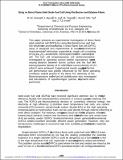Files in this item
Study on direct flame solid oxide fuel cell using flat burner and ethylene flame
Item metadata
| dc.contributor.author | Hossain, M.M. | |
| dc.contributor.author | Myung, J. | |
| dc.contributor.author | Lan, R. | |
| dc.contributor.author | Cassidy, M. | |
| dc.contributor.author | Burns, I. | |
| dc.contributor.author | Tao, S.W. | |
| dc.contributor.author | Irvine, J.T.S. | |
| dc.contributor.editor | Eguchi, K. | |
| dc.contributor.editor | Singhal, S. C. | |
| dc.date.accessioned | 2015-08-31T11:40:01Z | |
| dc.date.available | 2015-08-31T11:40:01Z | |
| dc.date.issued | 2015 | |
| dc.identifier | 213575308 | |
| dc.identifier | fbb79e26-336f-4571-829f-f503bbce9ed7 | |
| dc.identifier | 84938811886 | |
| dc.identifier.citation | Hossain , M M , Myung , J , Lan , R , Cassidy , M , Burns , I , Tao , S W & Irvine , J T S 2015 , Study on direct flame solid oxide fuel cell using flat burner and ethylene flame . in K Eguchi & S C Singhal (eds) , 14th International Symposium on Solid Oxide Fuel Cells, SOFC 2015 . ECS Transactions , no. 1 , vol. 68 , Electrochemical Society , pp. 1989-1999 . https://doi.org/10.1149/06801.1989ecst | en |
| dc.identifier.isbn | 9781607685395 | |
| dc.identifier.issn | 1938-5862 | |
| dc.identifier.other | ORCID: /0000-0002-8394-3359/work/68280701 | |
| dc.identifier.uri | https://hdl.handle.net/10023/7364 | |
| dc.description | The authors thank EPSRC SuperGen Hydrogen Fuel Cells Challenges Flame SOFC Project (Grant No EP/K021036/1) for funding. | en |
| dc.description.abstract | This paper presents an experimental investigation of direct flame solid oxide fuel cell (SOFC) by using a flat-flame burner and fuel-rich ethylene/air premixed flames. A direct flame fuel cell (DFFC) setup is designed and implemented to measure electrochemical characteristics of electrolyte supported (i.e., single cell consisting of Ce0.9Ni0.1O2-δ anode/GDC electrolyte/LSCF-GDC cathode) fuel cell. The fuel cell temperature and cell performance were investigated by operating various fuel/air equivalence ratios and varying distance between burner surface and the fuel cell. A maximum power density of 41 mW/cm2 and current density of 121 mA/cm2 were achieved. Experimental results suggest that the fuel cell performance was greatly influenced by the flame operating conditions and cell position in the flame. The uniformity of the flame temperature and the fuel cell stability were also investigated and calculations of equilibrium gas species composition were performed. | |
| dc.format.extent | 11 | |
| dc.format.extent | 242116 | |
| dc.language.iso | eng | |
| dc.publisher | Electrochemical Society | |
| dc.relation.ispartof | 14th International Symposium on Solid Oxide Fuel Cells, SOFC 2015 | en |
| dc.relation.ispartofseries | ECS Transactions | en |
| dc.subject | Electrodes | en |
| dc.subject | Electrolytes | en |
| dc.subject | Ethylene | en |
| dc.subject | Fuel cells | en |
| dc.subject | Fuel storage | en |
| dc.subject | Solid electrolytes | en |
| dc.subject | Electrochemical characteristics | en |
| dc.subject | Equivalence ratios | en |
| dc.subject | Experimental investigations | en |
| dc.subject | Fuel cell performance | en |
| dc.subject | Fuel cell stability | en |
| dc.subject | Fuel cell temperature | en |
| dc.subject | Maximum power density | en |
| dc.subject | Operating condition | en |
| dc.subject | QD Chemistry | en |
| dc.subject | NDAS | en |
| dc.subject.lcc | QD | en |
| dc.title | Study on direct flame solid oxide fuel cell using flat burner and ethylene flame | en |
| dc.type | Conference item | en |
| dc.contributor.sponsor | EPSRC | en |
| dc.contributor.institution | University of St Andrews. School of Chemistry | en |
| dc.contributor.institution | University of St Andrews. EaSTCHEM | en |
| dc.identifier.doi | 10.1149/06801.1989ecst | |
| dc.identifier.grantnumber | EP/K021036/1 | en |
This item appears in the following Collection(s)
Items in the St Andrews Research Repository are protected by copyright, with all rights reserved, unless otherwise indicated.

